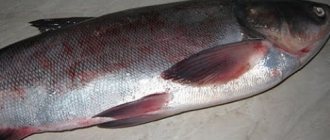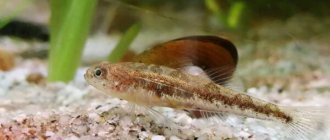What sense organs do fish have?
The sensory organs of fish, which directly influence their behavior in various situations, are the organs of vision, touch, smell, and the lateral line of hearing. With their help, fish determine the temperature of the environment, distinguish colors, determine the quality of water and the tastes and aromas of various objects and objects.
Tactile sensations have a great influence on the behavior of fish. The body of the fish is covered with many nerve endings, thanks to which it is easy for fish to navigate in the aquatic world.
Cutaneous sensory organs of fish
The simplest formations that perceive various irritations in the skin layer are free nerve endings. The thinnest terminal sections of the nerves branch widely throughout the skin and capture various irritations, in particular, in human skin, irritation of these endings causes pain.
The next stage of differentiation in the structure of the tactile skin organs can be considered tactile cells originating from the epidermis. They often have the appearance of ellipsoidal bodies entwined with the finest nerve endings. If such cells are collected in groups, such formations are called tactile spots. In some cases, their structure becomes even more complicated; tactile spots are surrounded by connective tissue membranes and tactile corpuscles are formed.
We find the latter formations in the skin of some fish, but they are especially characteristic of terrestrial vertebrates. There are many of them in the skin of amphibians; In birds they are confined to the soft parts of the beak; in the skin of mammals they are found in areas devoid of hair, or distributed around the vagina of long, sensitive hair, characteristic, for example, of the nasal region.
In fish, a highly differentiated lateral line serves as a unique organ of cutaneous sense.
Taste and smell in fish
Two openings on the frontal part of the head - the nostrils - are responsible for the sense of taste and smell in fish. Just like a human nose, fish have these holes to detect the smells and tastes of different objects. The olfactory organ in fish allows them to accurately determine the path to the spawning ground or find plant and animal food in the water.
The sense of smell is best developed in those fish that like to lead an active lifestyle at night and in places with low light. Such fish include burbot, catfish, bream, eel and, to some extent, carp. They distinguish salty, sweet, sour and bitter smells very well.
Taste buds are located inside the mouth, in the jaw area and on the whiskers of fish. If you look at how developed the oral organ is in bream and carp, and how easily they find food, then a lot becomes clear. For example, some fish species delay play away from their main habitats. These include, first of all, eels, salmon, roach, roach and crucian carp to some extent.
Interestingly, the fry, hatching from the eggs, cannot know where their natural habitat is. But they quickly find their way many hundreds of kilometers away and find themselves among their relatives. A striking example is salmon, which are born in the sea and then head home at high speed. Moreover, they find exactly the river where salmon live. They determine their native element by the composition of water and its taste. The olfactory organs are responsible for this. With their help, fish accurately determine for themselves the water in which they could live with the greatest comfort.
The same can be said about acne. These fish swim thousands of kilometers to lay eggs. And they easily find their native river. It is not surprising that at night these fish easily find worms and other food. By and large, they need vision for so many reasons.
The function of the organs of taste and smell is to determine the acidity of the environment and the amount of oxygen in the water. That is why the same bream or silver bream will not live in muddy areas of the reservoir. This water composition is not suitable for them, unlike crucian carp or crucian carp. Roughly speaking, if you artificially place fish in an environment that is unnatural for them, they will not take root there. The nostrils of fish are not connected to the nasopharynx. Therefore, taste buds are scattered throughout the body: on the antennae, fins and gills, as well as on the skin.
Eloquent examples are catfish and burbot, which love to hunt at night. These fish have very well developed organs responsible for tastes and smells: whiskers, fins and nostrils. With the help of whiskers and fins, burbot easily finds food in cold and dark times. Catfish do exactly the same thing, only in the warm season.
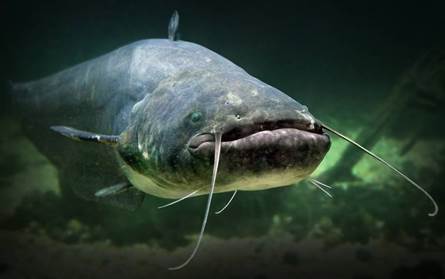
Most peaceful and predatory fish detect the electrical conductivity of water. The pits located on the body are responsible for this ability.
Fishermen should clearly understand that the sense organs discussed above affect the fish’s bite. Therefore, you can often find advice that you should not overdo it with flavorings. Humans and fish have a certain threshold of sensitivity to smells. When it passes, neither taste nor smell is felt. To understand how this can be, it is enough to inhale the aroma of a strong liquid concentrator with a pronounced odor. At first there is a smell, but then adaptation occurs. If you inhale a liquid with a stronger odor, you will not detect anything. The same thing happens with fish. If you throw bait with too strong a smell, the fish will not be able to distinguish it from the ground at the bottom by smell.
Olfactory organ in fish. How does he work?
Anglers who use bait for fishing notice that the fish purposefully rush to this place. Hence the logical conclusion: Fish definitely have an organ of taste and an organ of smell.
The purpose of these organs is beyond doubt: they help fish when searching for food.
Table of contents:
How does a fish's sense of smell work?
↓ Taste organs in fish ↓
Sense organs of freshwater fish: their importance when searching for food ↓

237 kilograms of fish from one hole!
The detained fishermen told the secret of a good bite. The fishery inspectors were surprised by the lack of prohibited equipment...
Read more
We all remember how the sense of smell works in the air from school:
— Molecules of some substance break away from it and fly in the air. When these particles enter the olfactory organs of people or animals, we feel them. This is called smelling.
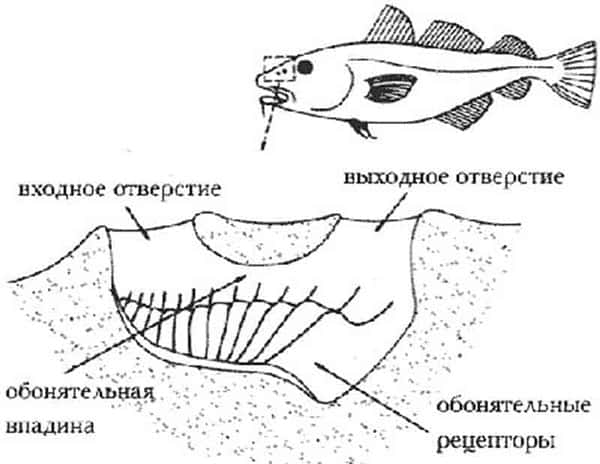
But how does this happen in water?
It turns out, almost the same. Substances can be dissolved in an aquatic environment or be suspended there. And, a well-developed sense of smell gives the fish the ability to sense even the smallest particles of something unusual.
The olfactory organs of fish include nasal pits, divided in half. The holes are located on both sides of the head and lead into the nasal cavity, which is lined by the olfactory epithelium.
There are two holes on each side: water enters one, water exits the other. This feature in fish allows substances dissolved or suspended in water to irritate the mucous membrane of the cavity, nerve signals about this enter the brain and cause a corresponding reaction to the smell.
It is worth noting that nocturnal and crepuscular fish have the strongest sense of smell - these are carp, tench, catfish, and eel. But daytime hunters, predatory pike, perch, and asp have an underdeveloped sense of smell.
3 ways to improve your fish bite!

Over 15 years of active fishing, I have found many ways to improve the bite, and here are the most effective:
1. Bite activator . This pheromone additive attracts fish most strongly in cold and warm water. The Fish Hungry bite activator has proven itself to be excellent - Read more…
2. Tackle with increased sensitivity . You should first familiarize yourself with the features of using a particular type.
3. Pheromone baits . They attract the attention of fish, stimulate hunger and cause a schooling reflex, which allows you to collect a lot of fish in one place.
You can get the rest of the secrets of successful fishing for free by reading my other materials on the site.
3 ways to improve your fish bite!
Over 15 years of active fishing, I have found many ways to improve the bite, and here are the most effective:
1. Bite activator . This pheromone additive attracts fish most strongly in cold and warm water. The Fish Hungry bite activator has proven itself to be excellent - Read more…
2. Tackle with increased sensitivity . You should first familiarize yourself with the features of using a particular type.
3. Pheromone baits . They attract the attention of fish, stimulate hunger and cause a schooling reflex, which allows you to collect a lot of fish in one place.
You can get the rest of the secrets of successful fishing for free by reading my other materials on the site.
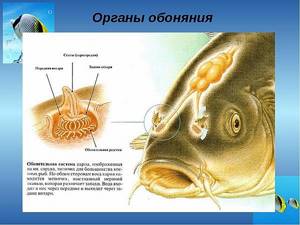
Vision in fish
It is easy to notice that every fish has a pair of eyes. Like other living things, the eyes are responsible for vision. This organ is differently adapted to water in different species of fish. The same burbot is practically blind. Catfish also do not have visual acuity. But the same pike or grayling are very well versed in both colors and shades. For them, vision is one of the main senses.
It has been established that fish are able to see well at a distance of 5 to 15 meters. Then only the silhouettes differ. This is due to the structural features of the lens and retina. In general, there is a clear relationship between the size of the eye and the ability to see. The more eyes, the farther their owner sees.
Using vision, fish detect prey or predators. Her eyes help her to hunt well, or to hide in time and not become an easy prey. Vision allows you to determine the size of objects, their shape, as well as find food and determine the distance between objects.
As for the ability to distinguish colors, they are better developed in predatory fish than in peaceful ones. Generally speaking, predators distinguish approximately the same number of colors as humans.
When talking about the objects that fish see, some nuances stand out. In the water she sees them just like a person. And she perceives objects located behind the water environment differently. Insects that lie on the surface of the water are clearly visible. Objects that are on the shore and people are visible blurry.
The fish does not see objects at the bottom so clearly, but determines their location accurately. The fish sees best objects that are located on the same level as it. Since her eyes are located on the side, her viewing angle is greater than that of those living organisms whose eyes are in the front.
Thus, it can be argued that the fish perceives objects that move on the surface of the water well. This explains the good performance when fishing with fly and spinning rods using surface baits. Predatory fish notice the color of baits and see outlines and various elements.
Can fish smell?
08.08.2018 Drozd Nikolaevich Animals
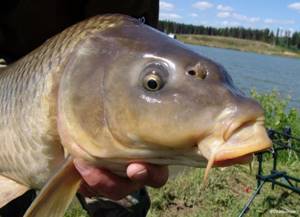
Of course fish have a sense of smell! Have you noticed that fish have nostrils on their heads? But the vast majority of fish do not breathe through their nostrils. Their nostrils lead into blindly closed sacs. However, a current of water is created through these bags. The entrance to the nostril in many fish is divided into two holes, and through one the water enters, and through the other it leaves due to the beating of the cilia (these are not the same cilia as we see, but microscopic mobile cell outgrowths).
Inside the bags there are special cells of the olfactory epithelium. They also have eyelashes, but they are immobile. They are immersed in mucus. These cilia perceive odors. From the other end of the cells extend the nerve processes that make up the olfactory nerves. They transmit information about odors to a special part of the brain - the olfactory bulbs.

Human olfactory system.
In most fish, the olfactory epithelium occupies a large area, and the olfactory bulbs are large compared to other parts of the brain. And observations of fish behavior show that smells play an important role in their lives. Sex pheromones have been found in some fish - odorous substances that serve to attract individuals of the opposite sex. Many fish also have “alarm pheromones” - they are released from the fish’s skin when injured and serve as a danger signal for other fish. Salmon find their way to their native river by the smell of the water when they return from the sea to spawn. Even more often, fish use their sense of smell to search for food. For example, sharks smell the blood of a wounded victim.
Relatively recently, it became clear that the cells of the olfactory epithelium have very diverse receptor proteins - special molecules with which molecules of odorant substances bind. A comparison of different animals has shown that if there are many varieties of such proteins, then the sense of smell is well developed - the animal can distinguish many odors and has a delicate sense of smell, that is, it smells substances with a lower content in the air or water. A special gene is responsible for each such protein. If the sense of smell loses its important role compared to, for example, vision, then some of these genes deteriorate during evolution. Then the protein for which such a gene was responsible is no longer formed. The higher the percentage of “broken” genes, the less the role of smell. In the well-studied zebrafish, there are approximately 150 working genes and about 50 “broken” ones; in the clawed frog, 410 genes work and 480 are “broken”; different birds have only from 100 to 670 genes, and at least half of them work; in a mouse, about 1100 genes work and about 300 do not work; In humans, approximately 390 genes work and more than 400 (according to other sources, about 700) do not work. Judging by these data, even birds have a fairly well-developed sense of smell (although until recently it was thought that most birds lacked it).
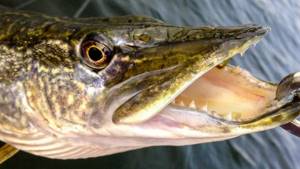
Interestingly, some receptor proteins are responsible for sensing substances dissolved in water, while others are responsible for sensing volatile substances carried through the air. Fish have almost exclusively “water” receptors—fish are not interested in the smell of flowers. In birds and mammals, receptors are almost exclusively “air”. But the frog has both: perhaps tadpoles need “water” receptors, and maybe some adult frogs can smell something both under water and on land.
In general, almost all organisms have the ability to recognize the presence of odorous substances in water or air - even bacteria and plants. Yes, yes, plants also “smell” some substances! For example, a plant chewed by herbivores releases ethylene into the air, and it serves as an alarm signal for neighboring plants - they begin to intensively produce toxic substances to protect themselves from being eaten.
The only studied group of animals that have no (or almost no) sense of smell are toothed whales (dolphins, killer whales and sperm whales). They have neither olfactory bulbs nor olfactory nerves. And most of their olfactory receptors (about 80%) do not work. This is not surprising - after all, their ancestors lived on land and lost their “water” receptors. And when the whales fully adapted to life in the water, they stopped being interested in “airy” smells, just like the fish.
Why, after all, have not all the genes of the olfactory receptors deteriorated in whales? Perhaps the remaining receptor proteins are responsible for the perception of sex pheromones - odorous substances that serve for communication between males and females in many mammals. These odors are perceived in mammals by a special vomeronasal organ, which in whales is poorly developed, but still, perhaps, works. And another explanation is possible. The fact is that olfactory receptor proteins are found not only on the cells of the olfactory epithelium, but also on some other cells. And there they can perform completely different functions.
Source: animalworld.com.ua
fish
Tactile sensations of fish
Pisces are good at determining the properties of objects when touching them. They also determine the temperature of the water. Any mechanical effects on the fish’s organs are transmitted through nerve endings. With the help of these senses, fish maintain contact with the outside world. Anglers do not always take into account the peculiarities of the tactile sensations of fish and make mistakes when fishing.
What is meant by tactile sensitivity in fish? First of all, this is a reaction to touching objects, to their movements, vibration and contact with various parts of the fish’s body. This is one of the manifestations of touch - the ability to sense objects through touching them.
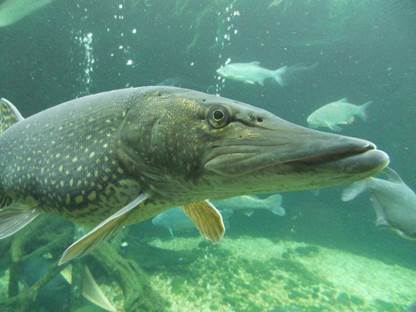
How can fish’s ability to tactilely sense objects affect fishing? This manifests itself in different ways. For example, if you covered the bait table, you created a spot on the bottom. If the color of the bait does not alarm peaceful fish, then they begin to try the food. At the same time, the sense of smell and touch is activated. When the fish tastes grains, large and small particles of food, as well as animal components, it also evaluates the hardness of the components. If the fish is not very hungry, it may spit out solid pieces.
When catching predatory fish with all kinds of bait, there are single bites, after which the bite stops. It is quite possible that the same silicone or spinner was not to the liking of the predator, and after trying it, he spat it out.
When assessing objects in contact with them, fish use a whole range of senses. Subcutaneous tissues and mucous membrane are the main informants of fish. Thanks to the sensations received, the fish can act differently in different situations. Let's mention water temperature again. The behavior and activity of fish largely depend on how warm or cool the water is. She can determine temperature with high accuracy using her senses of touch.
The ends of the trigeminal nerve are located on the head of the fish, and parts of the spinal nerves are located on the tail and fins. They cover the body of the fish. With their help, they sense various objects, as well as pain.
Organs of taste, touch and balance of fish
Organs of taste
Taste is a sensation that occurs when food and some non-food substances act on the taste organ.
Let us note that, judging by the literature, its study has received less attention than the study of other sensory organs of fish. This may be due to the fact that the variety of “taste” sensations is determined primarily by the sense of smell.
But, nevertheless, much is known about the taste organ of fish, and the available information about it can be used in fishing practice.
Taste sensations in fish, like in other living beings, appear through irritation of the so-called taste buds, or taste buds, which in fish are located in the mouth, on the antennae, and are also scattered throughout the body. The largest number of them, as well as the elements of touch, are located on skin outgrowths and antennae.
The main components of taste are four components: sour, sweet, salty and bitter. Other types of taste are combinations of these four sensations, and sensations in fish can only be caused by substances that are soluble in water.
The minimal perceptible difference in the concentration of solutions of substances - the threshold of difference - gradually worsens when moving from weak concentrations to stronger ones. For example, a 20% sugar solution has an almost maximally sweet taste, and a further increase in the sugar concentration does not increase the intensity of the taste sensation.
The appearance of taste sensations can be caused by the action on the taste receptor not only of adequate stimuli, for example, direct electric current. With prolonged contact of a substance with the organ of taste, its perception is dulled (that is, the taste of the substance becomes less distinct) and, in the end, this substance will seem completely tasteless. The functioning of a taste analyzer proceeds on the basis of general principles characteristic of all analyzers.
The taste analyzer can influence some reactions of the body that seem to have little to do with it; in particular, it affects the activity of some internal organs.
It has been established that fish react to almost all tasteful substances and at the same time have an amazingly subtle taste. Positive or negative reactions of fish (as well as animals) are determined by their lifestyle and, above all, the nature of their diet. Positive reactions to sugar are characteristic of animals eating plant and mixed foods. The sensation of bitterness causes a negative reaction in most living beings, but not in those who eat insects.
The taste organs are in constant interaction with other senses, but they are most closely connected with the sense of smell. However, the electrical potentials that arise when the receptors are exposed to taste substances differ from the potentials of other receptors.
It should be noted that there is no unified theory of taste yet. According to the ion theory, ions formed when substances come into contact with taste buds excite sensitive nerve endings. According to another theory, an important role is played by the potential difference between the protoplasm of the cell and the environment, formed as a result of the adsorption of the flavoring substance. According to these theories, the sensation of sour is due to the movement of ions, while that of bitter is primarily due to adsorption processes.
It seems that everything that has been said fits well with the recommendations of experienced fishermen. For example, you cannot overfeed fish; supplements and baits should contain more flavoring, but not high-calorie components. You cannot use old, sour baits, fertilizers, or baits. The fish don't like them, and this will definitely affect the catches.
Touch According to the existing classification of sense organs, touch is a complex complex of heterogeneous sensations coming from the skin and mucous membranes in contact with the external environment, as well as from the muscular-articular apparatus of animals, caused by several external stimuli. These irritants include: mechanical (tactile, pressure, vibration), temperature (cold, heat) and pain.
And such concepts as “skin sensitivity”, “skin analyzer” relate only to these three types of irritations; researchers have not yet gone beyond these concepts.
The data available in the literature today, I am convinced, is sufficient to make some adjustments to the understanding of the role of the organ of touch in the life of fish. Let's talk about skin sensitivity. In addition to sensitive formations that perceive mechanical, temperature and pain stimuli, photosensitive cells that react to light were found on the surface of fish skin.
In the lateral line, which is a skin formation, sensitive elements were found that perceive sound signals and are the organs of smell, balance and location for fish.
We can say that the skin of fish contains sensory organs that respond to all basic physical phenomena - light, sound, mechanical and chemical influences. The concept of “skin sensitivity” in connection with the above should be expanded.
As for the “skin analyzer,” then, in my opinion, it is incorrect to consider it an analyzer of three essentially different irritations.
Academician I. Pavlov received the Nobel Prize, among other things, for the discovery of analyzers, which include nerve endings located on the surface of the skin - receptors (sensory organs) and nerve fibers that conduct nerve impulses from the receptor to the brain center, where the signal is analyzed and formed the body's response to the received irritation. The analyzer may contain a receptor that responds only to one specific (adequate) stimulus.
Research has shown that the analyzers included in the organ of touch have their own receptors, their own pathways, and in the higher parts of the brain they are represented by separate centers (with the exception of the pain receptor). There are different opinions about the pain receptor.
Some consider it to be an independent receptor, others believe that the sensation of pain occurs when any receptor is overstimulated, causing its destruction. It must also be said that mechanical stimuli do not act equally on all receptors: stimuli of varying intensity are perceived by different nerve endings. The same applies to temperature sensitivity: cold is perceived by some analyzers, and heat by others.
I would especially like to note that the temperature factor for the life of fish as cold-blooded animals is of priority importance; cold sensitivity is especially important in the conditions of our latitudes. This factor controls the most important biorhythms of fish. A lot suggests that the reaction to this factor is carried out by an independent sensory organ, and it should be discussed separately and, of course, not only because there are separate receptors for heat and cold.
All of the above, I think, leads to the idea that the sense of touch in fish should include only tactile sensitivity, i.e. response to touch, pressure and perhaps vibration. As for the perception of vibration by fish, there is a lot of uncertainty. Scientists have identified the pathways for the perception of vibration by fish: elements presumably related to the perception of vibration have been found in the inner ear, but it is unclear with which skin endings they are connected.
A number of works do not mention the perception of vibration at all; they only say that stimulation of tactile receptors gives two main types of sensations - touch and pressure, which should be considered as different degrees of sensation of the same quality.
And further, it has been established that sensations of touch and pressure arise in fish only if a mechanical stimulus causes local deformation of the skin surface, and if the pressure is distributed over the entire surface, be it atmospheric, hydrostatic or any other, then it does not affect the fish. is felt. It should, however, be assumed that fish have corresponding sense organs for all types of pressure; they will be discussed below.
Vibration most likely affects the entire skin surface of fish, and, therefore, the organs that perceive vibration should also be separated from the system of tactile organs.
What is known about the tactile sensitivity of fish? Sensitive cells of this organ are located throughout the body, reaching the greatest concentration on the lips, antennae and fins. In fish that live in turbid water, the antennae, fins and areas of the body located on the skin outgrowths are most sensitive. It is believed that the lateral line also performs the function of touch in fish.
With the help of sensitive elements located in it, fish are able to sense the direction and strength of the current. Researchers also believe that fish exchange signals using their tactile organ.
This is, perhaps, all that is known about the tactile organs of fish. One can understand the difficulties of researchers who study the functions of these organs. But the information already obtained is enough to understand the significance of these organs for fish. Their work together with other sensory organs of fish is important in carrying out the functions of nutrition, reproduction, etc.
Organ of balance
The organ of balance in its structure is no fundamentally different from similar organs of terrestrial animals and humans. The peripheral (receptive) part of the vestibular analyzer (equilibrium analyzer) of fish is located in the inner ear, in the so-called labyrinth, divided into two parts, the bases of which are covered with cells in the form of hairs, to the ends of which crystalline formations are “glued” - otoliths (statoliths).
I would like to note that among otoliths of the same size, nature has placed one otolith that is much larger in size; it will be discussed below. One of the parts of the labyrinth is an organ of balance: when the position of the body changes, the otoliths shift under the influence of gravity, and the tension of the hairs changes.
The signal about this, received by the brain, is analyzed, and then, with the help of a complex system of reflexes, including the activity of the body’s muscles, tendons and joints, the active posture of the body is restored.
The function of the second part of the maze has not yet been established. Some scientists believe that it is a special receptor for vibration sensitivity.
This system of reflexes, connected directly to the vestibular apparatus, constantly determines the location of the body’s center of gravity and maintains it at a point at which the sum of all momentary forces acting on the body must be equal to zero (this allows one to maintain balance).
How important is the function of the balance organ for fish? It can be said with certainty that without his participation the normal functioning of the fish’s body is impossible, there cannot be normal movement, and normal communication with the outside world is practically lost due to distortions in the perception of its senses.
Researchers note the close connection of the organ of balance with other senses, especially vision, and their important role in maintaining balance. In the life of fish, this organ plays no less important, and perhaps a much greater role, than in the life of land animals. Unfortunately, this organ has not yet been sufficiently studied.
Fish live practically in a state of weightlessness, therefore, their sensitivity to gravity should be significantly higher than that of terrestrial animals. Fish do not have a neck or limbs, which play a role in maintaining balance. But fish have a swim bladder, which to some extent compensates for the absence of these body parts.
From practice we know that diseases, intoxications and explosions have a detrimental effect on the balance system of fish, the normal function of the swim bladder is disrupted, and the fish float to the surface, becoming prey for predators.
There is every reason to distinguish the balance organ of fish into a separate independent sensory organ. The participation of the swim bladder and the lateral line in the balance function suggests that the balance organ of fish is complex and consists not only of the inner ear.
The structure of the inner ear suggests certain thoughts; in this regard, I cannot help but express another unsubstantiated guess. If the above-mentioned otoliths, working on the gravitational principle, when displaced, give a signal about an imbalance of the body to the central nervous system, could they, or rather, the largest of them in size, during gravitational vibrations change the pressure on the underlying hairs and tissues and thus protrude? in the role of performer of the functions of the organ of gravitational sensitivity?
Perhaps the second part of the labyrinth, the function of which is still unclear, is somehow involved in this process.
The material was published in the one hundred and forty-second issue of the “Go Fishing” party
Organs of touch in fish
The organs of touch in fish are fins, whiskers, rostrum, and fin rays. With the help of these organs, fish form a clear picture of the surrounding world. Naturally, baits, baits, groundbaits are also evaluated by these bodies. In particular, whiskers and fins touch objects and thus evaluation occurs. Pisces can either accept or reject objects if they make them wary.
Spilling fish have differently developed whiskers. In catfish, burbot and barbel, the whiskers move due to developed muscles. With the help of the fish's whiskers, the taste and density of the fish are determined by an object at the bottom. A mustache is very helpful in cases where it is dark and visibility is limited. If the mustache is damaged for any reason, then it quickly loses its functions.
The rays of the fins are of great importance in the fish’s perception of the surrounding world. They are located in almost all fins: on the back and belly. In some species the rays are long, in others they are short. With their help, fish explore the bottom in search of animal food.
Using rays on the fins of fish, the density of food and its composition are determined. This is a very important point for anglers to consider. This is why there is a difference in bait for roach, crucian carp and bream. Depending on what fish we are targeting and what time of year, one or another bait composition is selected. The density and composition of the bait largely determines whether we will be able to place the fish on the spot or not.
All fish develop tubercles on their heads during spawning. During the spawning period, these tubercles are the main sensory organs.
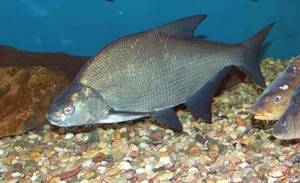
The organs of touch and tactile senses are more important for bottom fish - bream, catfish, burbot, eel, sleeper. It is these fish that have well-developed fins and whiskers. They help to navigate well in the bottom layer, find food and avoid predators.
Nervous system and sensory organs of fish
1. The nervous system of fish is represented by the brain and spinal cord
. The brain is divided into the following sections: forebrain, diencephalon, midbrain, cerebellum and medulla oblongata. Twelve cranial nerves, grouped in pairs, extend from the brain.
2. At the forebrain
there is no division into hemispheres, and accordingly, there is almost no cortex. At its anterior end are the olfactory lobes.
3. From intermediate
and
the midbrain,
the optic nerves go to the eyes. The midbrain of most fish is small. It contains the centers of visual reflexes.
4. Cerebellum
responsible for the movements of the fish, it is well developed.
5. Medulla
responsible for the functioning of the digestive system, the functioning of the respiratory center, heart and other organs.
Sense organs
1. Olfactory organs
- one nostril in cyclostomes and paired nostrils in all other fish, from which openings lead into the olfactory cavities, which are not connected, as is typical for fish, with the oral cavity. How do fish smell in water? The nostril is divided by a septum into two halves, water flows into one and exits through the other. It is at this moment that the fish has time to analyze the smell and determine in which direction the food is located.
2. Organs of touch
- body coverings, sensitive rays of fins and whiskers. Sturgeon have very funny whiskers, and catfish have phenomenal whiskers - thick and long.
3. Organs of taste
- taste buds growing on the lips, in the mouth and even on the antennae.
4. Organs of vision
- large eyes, which, alas, see poorly; already a couple of meters away the picture becomes blurred. For most fish, the doctor would prescribe glasses for myopia. But the angle of vision of fish is large, up to 170 degrees with one eye, and they distinguish colors perfectly. Daytime predators such as trout or pike see best. Some nocturnal fish have adapted to see in the dark; catfish, for example, have special nerves for this. Deep-sea fish have almost lost their eyes in the process of evolution.
5. Hearing organs
- the inner ear located in the skull. Fish do not have an external ear at all as it is unnecessary, because water conducts sound well, and fish feel it through the bones of the skull. This is why fishermen are so sensitive to loud sounds near the water.
6. Organs of balance
in the form of three semicircular canals are also part of the inner ear. The channels are paired, just like the hearing organ.
7. Side line
- an interesting organ of fish, something between the organs of touch and hearing. On the sides of the body, under the scales, there are channels with sensitive cells that detect the direction of movement and the strength of the water current (seismosensory value), as well as infrasound (low frequencies). Using the lateral line, fish can determine at what distance from them other fish, food, and various objects are located.
8. swim bladder
, first of all, guarantees buoyancy, thanks to the gases filling it. But in addition to this, it can participate in the breathing process and produce sounds. Yes, fish can make noise and even “talk” - they chatter their teeth, rub their fins against each other, make sounds by moving their swim bladder.
Do you want to pass the exam with flying colors? Click here - preparation for the Unified State Exam in biology (Moscow)
Lateral line in fish
The lateral line is a kind of bridge between the sense of touch and hearing in fish. In some cases, it can effectively replace vision. The lateral line, like a thread, runs from the head to the tail on the side of the body.
At the head the line divides and its branches surround the eyes and are located along the gills and lower jaw. Inside this organ there is fluid, nerve fibers that are connected to the brain. Thanks to the lateral line, fish feel confident in muddy water and at night and react to changes in water level and the strength of the current. With its help, they determine the depth in different parts of the water area, as well as vibrations. Therefore, it is necessary to walk very carefully along the shore and behave quietly in the boat and when fishing in a wade.
OLfactory ORGANS
Olfactory organs of animals and humans. A – diagram of the structure of the insect’s olfactory sensilla; B – enlarged segment of the antenna of a male peacock butterfly with lateral branches and olfactory senses...
OLfactory ORGANS, organs of multicellular animals and humans that provide the perception of the smell of odorous substances (OS). O. o. different groups of animals developed independently in the process of evolution and differ in structure and location. In most invertebrates O. o. and the taste organs are not yet divided and the composition of the environment is analyzed by the organs of general chemistry. feelings. In insects O. o. serve as olfactory sensilla located ch. arr. on the antennae; in mollusks there are olfactory pits located on different parts of the body. Unpaired O. o. (olfactory sac) of cyclostomes opens outward with an unpaired nostril. In fish O. o. represented by paired nasal pits, or bags, on the front of the head; on their walls there are connective plates. tissues covered with olfactory epithelium. In terrestrial vertebrates O. o. located in the nasal cavity. Their configuration is relatively simple in amphibians and reptiles, but becomes significantly more complex in mammals due to the development of a system of bony shells and whorls. Terrestrial vertebrates are also characterized by the separation of part of the olfactory sac into independent units. department - Yakobson organ. In humans O. o. located in the upper nasal passages and include on each side sections of the nasal concha and septum, covered with specialized. epithelium.
The smell of substances is perceived by chemoreceptors - olfactory receptor cells. They are the primary sensory (perceiving) cells, combining the function of a receptor that is affected by PVs and a nerve cell that sends signals to the brain about this effect. The number of such receptor cells varies in different animal species (for example, a shepherd dog has more than 200 million olfactory receptor cells, a rabbit has about 100 million, and a human has 10 million). These cells in vertebrates have two processes extending from opposite ends of their bodies. Peripheral the process is equipped with multiple thin projections - cilia, into the membrane of which a specific cilia is built. receptor protein. This process is immersed in a layer of mucus (secret) covering the epithelium. PV molecules enter the O. o. mammals during inhalation through the nostrils, and to a lesser extent from the oral cavity, through the choanae. PV dissolves in the secretion covering the epithelium and reaches the surface of the cilia of the olfactory cell, where it comes into contact with the receptor protein. This is accompanied by the opening of ion channels for calcium and sodium ions, which begin to enter the cell, and a shift in the electrical difference. potentials of the cell membrane (its depolarization), which leads to the generation of nerve impulses. The second process, the axon, is involved in the transmission of emerging impulses. Axons of all receptor cells of the O. o. form the olfactory nerve, which directs impulses to one of the oldest parts of the forebrain - the olfactory bulb, where the primary processing of sensory information coming from the olfactory receptor cells occurs. In a number of marsupials, the olfactory bulb makes up up to half the length of the cerebral hemisphere; in birds and primates it is poorly developed; in toothed whales it is absent. The axons of the mitral cells of the olfactory bulb form fibers of the olfactory tract, connecting it with the overlying structures of the brain that are part of the limbic system.
Chemical odor recognition substances occurs according to a combinatorial principle. PV activates many receptor cells (but not all) of the olfactory organs; different odors are recognized differently. their combinations. The number of possible combinations is many times greater than the number of these cells, which makes it possible to encode and distinguish a huge number of odors. PVs excite, in addition to olfactory receptor cells, also the sensitive endings of the trigeminal nerve fibers, which are located in the nasal mucosa and serve nonspecifically. general chemical receptors sensitivity. The participation of the trigeminal nerve in the formation of a complex sense of smell is especially pronounced for PV with a strong irritating odor (including acetic acid and ammonia).

